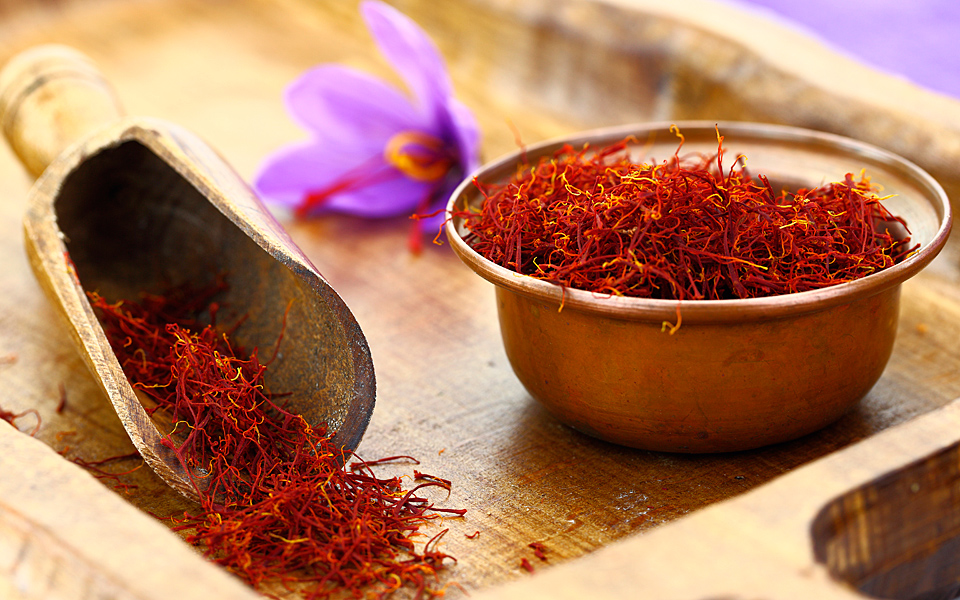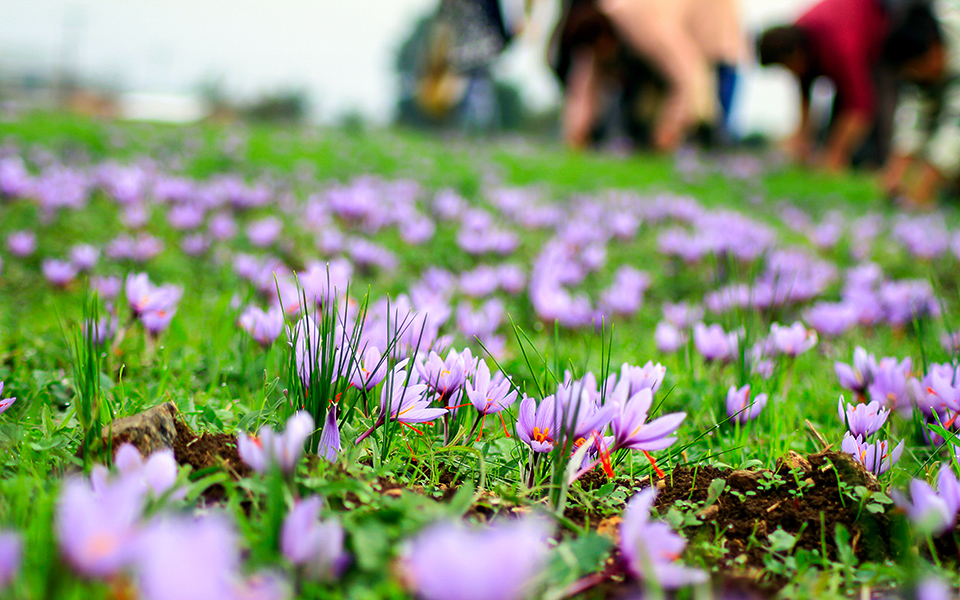In the plains of Tsarsampa, south of Kozani, all the way to Lake Polyfytos with its mild climate, the fields produce the best quality organic saffron in the world, carrying PDO certification. Kozani saffron has been grown here for the last 500 years. It was started by Kozani merchants with successful businesses in Central Europe who knew the value of the product. Saffron is also grown in Spain, Morocco and Central Asian countries, but Kozani saffron is considered top quality.
The crocus sativus plant is the type which gives long stigmas with a strong aroma and color. There are only three such strands per flower. They have a deep red color and only when wet does it turn a rich yellow, a color bearing all the warmth and intensity of sunlight.
The purple fields
The growing of saffron is not particularly demanding. The hard work, which is the harvest, takes about 20-30 days and begins around mid-October. The plant withers before summer. In the crocus fields, there is nothing to indicate the existence of the precious plant until early autumn along with the first cold and drizzle.
Then, experienced growers monitor the shoots to see how many buds they have which tells them how many flowers each plant will yield, and so conclude if it will be a good harvest or not. First, the purple flower blooms – the leaves follow later – blanket the fields with stunning beauty; a carpet of purple flowers without greenery. This is the signal for the growers. The flowers should immediately be gathered as soon as they bloom, otherwise the fibers wither. Early in the morning, they start gathering flowers and this continues many times into the afternoon. Since the plant grows only about 2.5 cm high, this involves a lot of bending over.
The workers cut the flowers skillfully by twisting them so as not to damage the plant. This leaves them with the petals, stamens and stigmas in their hands. They drop them in the pockets of the aprons they wear and, when filled, they empty them out into large woven baskets. They continue until they collect all the flowers, and then quickly transfer the floral harvest home, because the process of separating the valuable stigmas must begin immediately before the flowers wilt. Besides, the next morning, the field will be blooming again, so they will go back to collecting.

At the homes of the crocus gatherers, there is a rotating table onto which they throw handfuls of flowers, while a fan blows away the petals. This leaves the saffron fibers intermingled with stamens and petal fragments. They collect these and pass them to the next group sitting around a table to carry out the first sorting. Here, both young and old take part. The sorters work in groups of 2-3, and by the time they’re done their feet are deep in a carpet of purple petals.
The sorted strands are spread in thin layers on trays that are placed in an airy room with a temperature of 35 – 50 °C. The following day, they are collected again. The timely harvest and sorting ensures the quality of the product, so there is no time for rest. They eat as they work and fight off fatigue with stories which keep nerves and drowsiness in check. For each kilo of the final product, 150,000-170,000 flowers are needed, while each gram of saffron contains about 160-170 strands.
The Saffron Cooperative
By the time the difficult days of harvest are over, there is not a single speck of a foreign element to be found among the deep red saffron strands. They are then delivered to the cooperative where quality control using modern machines is carried out.
The Cooperative of Saffron Producers of Kozani is a special form of association. All the producers are members. Its headquarters is in the village of Krokos, with modern storage and packaging facilities for the product. Obviously, the process of harvesting and sorting the saffron is the main reason that this is the most expensive seasoning in the world, but the quantities needed for cooking are so small that it is now an affordable luxury. In addition to its unique color and deep aroma, saffron is good for you. Scientists studying the spice have found that it has exceptional properties: it is a thrombolytic, relieves the liver and soothes the stomach. Many doctors claim that it slows the signs of aging.
In cooking
The product is placed in glass jars or plastic boxes of one or two grams of strands. You can also find saffron powder in one gram boxes, which are divided into four packets so you can use as much or as little as you need.
It’s easy to use saffron in your cooking. You can add it to tomato-based foods so you’ll have the taste and aroma, but not the color. On the other hand, white ingredients will sparkle with the bright orange color that saffron lends. Always keep an eye on the quantity. For half a kilo of rice, a quarter of a gram is plenty if you like a light hint of saffron. If you want it a little stronger, add half a gram.
It’s best to leave the saffron strands in a bowl with water for 1-3 hours before using it so that it releases its color and aroma. If you’re going to use it in dough, then the strands should stay in the water for a few hours, even overnight. If your recipe allows it, use milk instead of water for the saffron intended for dough and pastry. The hotter the water you soak the strands in, the faster they will release their color and aroma.












